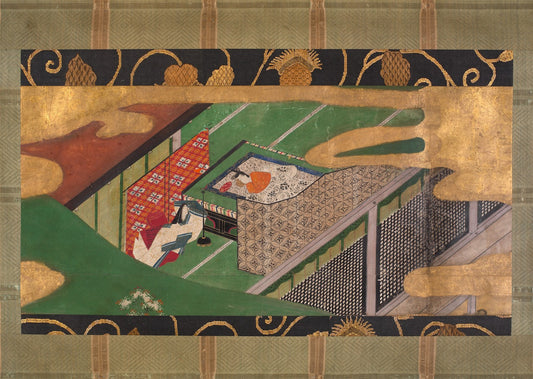Feature image: Houndstooth pattern via Adobe Stock
Cold weather is upon us, and we will again see Houndstooth skirts, pants, and dresses. It’s since become an ole-reliable for fall and winter style in department stores, and in some cases, becoming synonymous with neutral or “basics” in fashion. This print came from humble beginnings, worn by shepherds tending to their sheep. Its historical purpose is rooted in protection; however, today, it is used to allude to and display in clothing as an act of solidarity for late royal figures. From the Scottish lowlands to the runways of Paris, houndstooth's journey is a testament to its enduring influence on practical and high fashion.
In 360 AD, there is evidence of the very first versions of the print in Sweden, but more information is needed on its true origin and purpose. Artisan weavers in the Scottish Lowlands first made the pattern around 1800. Its purpose was to be worn for shepherds during work to provide them with a durable, identifiable fabric. The name came from the jagged shape of the pattern resembling the tooth of a hound dog. Its first name was actually “Sheppard print” before it shifted to “Dogstooth” and finally “Houndstooth.” The smaller versions of the print are also called “puppy tooth.”
However, while this was an identifiable fabric for shepherds to wear, there is scientific backing for its use as a camouflage in the pastures. According to the National Institutes of Health, tightly dotted or patterned objects with high color contrast cause issues in the human eye's perception of monocular and binocular cues, causing the wearer to appear farther away.
While the textile’s purpose was for practical and camouflaging purposes in Scotland, the print first became contemporary fashion in the mid-1800s. In the 1920s, Scottish clans officially claimed the pattern for tartans, or designs used for clan markers, though any clans never claimed it, so it remained open to use for all Scottish people.

Once synonymous with country estates and hunting attire, the houndstooth pattern has radically transformed into a symbol of urban sophistication. It hit one of its first surges of consumerist popularity in the 1930s when it began appearing in men’s coats and blazers, adding a patterned detail to an otherwise strict and monochrome fashion style.
In the 40s, its popularity waned as WWII required pooling all resources into the war effort, but in the 50s, Italians revived its appeal by incorporating it into athletic jackets. This use caught Christian Dior’s eye, who packaged his first-ever fragrance using this print, bringing Houndstooth’s first break into high fashion. From here, it quickly became synonymous with wealth and status as more members of the royal family wore it. Princess Diana wore houndstooth frequently on coats and blazers, often with red and cream colors, but still wore classic black and white.

However, there was an instance where the princess wore a black and white houndstooth coat, her head bowed down and concealed from the sea of cameras by a large hat. Her then-husband Prince Charles stood close by, the crowd remaining at a murmur. Suddenly, Diana lifts her face to look at the crowd, and her face turns bright from the sheer amount of camera flashes directed at her—the press simply could not get enough. After a few moments, she lowers her head again, the cameras phasing out of their photographic frenzy. This moment is referenced even today by royal historians to emphasize her impact on the world compared to the prince.
Diana even acknowledged these claims in a 1995 interview with BBC, saying "With the media attention came a lot of jealousy; a great deal of complicated situations arose because of that." Princess Kate also wears it, but specifically with multiple allusions to Diana. Whenever photographers capture Middleton in the pattern, a picture of Princess Diana swiftly tends to follow. As fashion often morphs and draws inspiration from historical figures' past ensembles, the houndstooth pattern has come to signify luxury and also represents a show of solidarity among royal figures even today.
Houndstooth’s use as a classic textile in high fashion still holds strong with no sign of it falling out of style. The thickness of the fabric is also used to change the body shape of the models on most runways, especially for fall and winter lines. Almost 70 years later, Dior still includes houndstooth on the runway, keeping their founder’s inspiration from the fabric alive. Chanel still uses it in the fall and winter collections, with Cara Delevigne wearing it on the 2019 runway; almost every aspect of her look incorporated the pattern.
The print originated from familiar Scottish people in the lowlands but morphed into this classic staple in wealthy wardrobes and high-end fashion. We see the print more accessible today with more diverse choices in clothing, still calling back to the original uses of the print in suit jackets, skirts, and pants. The shift from a shared cultural origin to a symbol of luxury is not new, especially for Great Britain, which associates royal houndstooth looks with Princess Diana’s fashion even today. Houndstooth's enigmatic appeal lies in its ability to seamlessly bridge the gap between classic and contemporary, embodying the duality of style itself. This timeless thread is here to stay as a clean, classic pattern, but it is important to recognize the history of the pattern and its origin as we continue to wear it.
©ArtRKL™️ LLC 2021-2023. All rights reserved. This material may not be published, broadcast, rewritten or redistributed. ArtRKL™️ and its underscore design indicate trademarks of ArtRKL™️ LLC and its subsidiaries.








